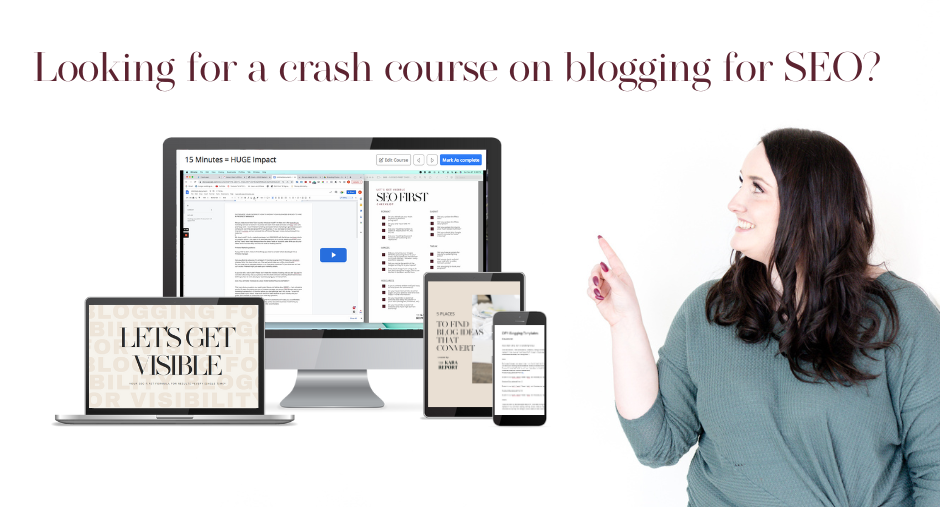Are you ready to start blogging for your business? Or maybe you’ve written a few posts and have started wondering how to write better blog posts? In this article, we’ll cover everything from brainstorming ideas and structuring your post to crafting attention-grabbing headlines and optimizing your content for search engines. With expert tips and practical examples, you’ll learn how to captivate your audience from the very first sentence and keep them hooked until the very end. Trust us – we know from experience. We’ve been ghost-blogging for our clients across industries (from wedding photographers to fashion designers), and it’s safe to say we’ve learned some tricks along the way.
By adopting a unique blend of creativity and strategy, we’ll show you how to deliver value, establish your authority, and drive more traffic to your blog. Whether you’re writing for a personal blog or a business website, mastering the art of creating compelling blog posts is an invaluable skill that will set you apart from the competition (and your readers will love you for it!).
Before we dive in, want to hire us to write blog posts for you? Head here for all the details on our ghost blogging packages.
Table of Contents
Understand your target audience
We have to start with the basics here, and understanding your target audience is a fundamental step in writing a better blog post. To create content that resonates with your readers, you need to know who they are, what they’re interested in, and what challenges they face. I’m sure you’ve heard that before!
Start by conducting market research to identify your target audience’s demographics, interests, and pain points. This can be something formal, or it can be as simple as a few Instagram polls. From there, take this information to create buyer personas to keep front and center as you start to write each blog post. By understanding your target audience’s motivations and needs, you can tailor your blog post to address their specific concerns. It can be a great way to come up with content ideas!
Once you have a clear understanding of your target audience, consider their preferred communication style. Are they looking for a casual and conversational tone, or do they prefer a more formal approach? Adapting your writing style to match your audience’s preferences will make your blog post more relatable and engaging. Most people do NOT want a blog post to feel rigid and formal, but not everyone wants to much personality infused you can’t understand what the blog post is actually saying.

Keyword research and SEO optimization
We are passionate about this one! If your blogging strategy hasn’t worked in the past, one of the key elements of writing a better blog post is to make sure you are optimizing it for search engines.
Start by conducting keyword research to identify the terms and phrases your target audience is searching for. There are various tools available, such as Google Keyword Planner and SEMrush, that can help you find popular and relevant keywords for your blog post. One of our personal favorites (especially for new bloggers) is Ubersuggest!
Once you have a list of keywords, strategically incorporate them into your blog post. Place them in your headline, subheadings, and throughout the body of your content. However, be mindful of keyword stuffing, as it can negatively impact your search engine rankings (and your reader will hate it, too). Instead, focus on creating high-quality content that naturally incorporates your keywords.
Along keywords, there are several other techniques you can employ to optimize your blog post for better visibility in search engines. Make sure to optimize your meta tags, including the title tag and meta description, to provide an accurate description of your content and encourage users to click through to your blog. Additionally, consider using descriptive URLs, alt tags for images, and both internal and external links to further enhance the SEO of your blog post. These strategies will help more readers discover and engage with your valuable content!
Craft an attention-grabbing headline
The headline of your blog post is the first impression your readers will have of your content but it can be hard to come up with a good headline that ALSO incorporates your main keyword. Here are a couple of strategies we employ for our clients:
Using power words and numbers: For example, “10 Tips for…” or “The Ultimate Guide to…”.
Make your headline promise a benefit or solution to your readers: the headline for this blog post is a good example!
Structure your blog post for readability
Did we say readability? We mean skimmability. Most people are skimming nowadays (in fact, there’s a good chance you aren’t reading this – you are just skimming the headlines!).
By organizing your content into sections and using headings and subheadings, you can make it easier for your readers to navigate and digest your blog post. Here are a few tips to make it easier on yourself:
Start by outlining your blog post before you start writing. This will help you organize your thoughts and ensure a logical flow of ideas. Consider using a hierarchical structure, with main sections and subsections, to guide your readers through your content.
Use headings and subheadings to break up your content and make it scannable. This allows readers to quickly find the information they’re looking for and encourages them to read the entire blog post. Additionally, use bullet points, numbered lists, and short paragraphs to make your content more digestible.
Incorporating visual elements, such as images, infographics, and videos, can also enhance the readability of your blog post. Visuals not only break up the text but also provide additional context and engagement for your readers. Think about what YOU like to see online and find inspiration from that.
Write compelling and informative content
This one is kind of a no-brainer, right? The heart of writing a better blog post lies in its content.
Start by grabbing your readers’ attention with a captivating introduction. Use a compelling anecdote, a thought-provoking question, or a surprising statistic to engage your readers from the very first sentence. In our experience, you don’t have much time to get them hooked!
As you progress through your blog post, provide valuable information and insights that fulfill the promise you made in your headline. Use examples, case studies, and personal experiences to illustrate your points and make your content relatable. If you want to rank on Google, you need to SHOW them you know your stuff!
On top of that, make your content actionable by providing practical tips, step-by-step guides, or actionable takeaways. Your readers should be able to apply the information you provide and see tangible results. Will they leave knowing what the next step is?
Last but not least, to keep your readers engaged, use a conversational and friendly tone. Write as if you’re having a conversation with a friend, avoiding jargon or overly complicated language. By creating a personal connection with your readers, you’ll make your content more relatable and enjoyable to read.

Adding visuals and multimedia elements
Incorporating visuals and multimedia elements into your blog post can greatly enhance its impact and engagement. Images, videos, infographics, and other visual elements not only break up the text but also provide additional context and appeal to different learning styles. On top of that, like every other algorithm, Google prioritizes pages with video because it often signifies unique content (and let’s be honest, there is becoming less and less of that these days).
Start by selecting high-quality and relevant images that complement your content. Use images that are visually appealing, evoke emotion, and help illustrate your points. Additionally, optimize your images for web by compressing them and using descriptive alt tags.
While branded images are great, it doesn’t stop there. Infographics are a great way to present complex information in a visually appealing and easy-to-understand format. Create or find relevant infographics that summarize key points or present data in a more digestible way.
As we mentioned above, videos are another powerful tool for enhancing your blog post. Consider embedding relevant videos from platforms like YouTube or Vimeo to provide additional insights or demonstrate concepts. Videos can also increase the time readers spend on your blog post, boosting engagement and reducing bounce rates.
Incorporate internal and external links
In my blogging course, I talk about how more than anything else, Google wants us to be a genuine resource. Incorporating internal and external links into your blog post can provide additional value to your readers and improve your blog’s SEO.
Proofread and edit your blog post
Again, another obvious one, but we also want to add that you should consider having someone else on your team or a family member or friend proofread for you. As someone who has written hundreds on blogs in my lifetime, I’m telling you that it can be HARD to proofread your own work. Here are a few more tips for you:
Start by taking a break after writing your blog post. This will help you come back to your content with a fresh perspective and identify any mistakes or areas for improvement.
Read your blog post out loud to yourself or have someone else read it to you. This can help you identify awkward phrasing, unclear sentences, or grammatical errors that you may have missed when reading silently.
Check for consistency in your writing style, tone, and formatting. Ensure that headings and subheadings are consistent, paragraphs are well-structured, and your tone remains consistent throughout your blog post.
Additionally, pay attention to punctuation, spelling, and grammar. Use grammar-checking tools or proofreading software to catch any errors you may have missed. We use Grammarly and the Hemingway Editor regularly.
Ready to Write Better Blog Posts?
Congratulations! You’ve reached the end of this comprehensive guide on how to write better blog posts. By implementing the tips and techniques discussed in this article, you’ll be well on your way to transforming your writing from beginner to expert. Remember, writing a good blog post is a skill that takes practice and dedication, so keep honing your craft and never stop learning. If you want support, we would love to see you inside our blogging mini-course next!
